oil NISSAN 300ZX 1984 Z31 Engine Fuel And Emission Control System Workshop Manual
[x] Cancel search | Manufacturer: NISSAN, Model Year: 1984, Model line: 300ZX, Model: NISSAN 300ZX 1984 Z31Pages: 79, PDF Size: 2.15 MB
Page 2 of 79
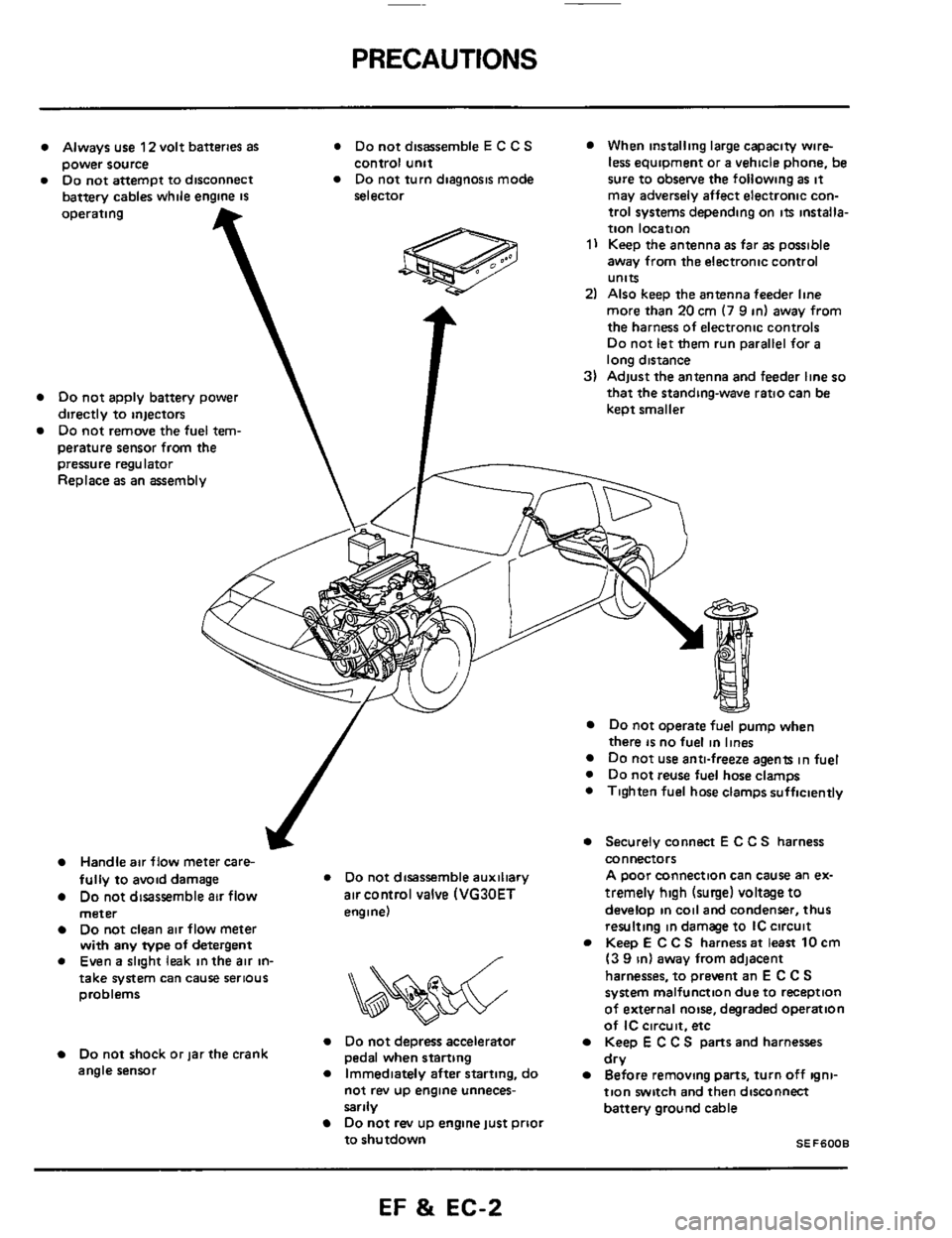
PRECAUTIONS
Always use 12 volt batteries as * Do not disassemble E C C S When installing large capacity wire-
Do not attempt to disconnect Do not turn diagnosis mode sure to obsetve the following as it power source
battery cables while engine
IS
control unit
selector less equipment or a vehicle phone, be
may adversely affect electronic con-
operating
Do not apply battery power
directly to injectors
Do not remove the fuel tem-
perature sensor from
the T
pressure regulator
Replace as an assembly
trol systems depending on its installa-
tion location
1) Keep the antenna as far as possible
away from the electronic control
units
2) Also keep the antenna feeder line
more than
20 cm (7 9 in) away from
the harness of electronic controls
Do not let them run parallel for a
long distance
3) Adjust the antenna and feeder line so
that the standing-wave ratio can be
keot smaller
J
Handle air flow meter care-
fully to avoid damage * Do not disassemble auxiliary
Do not disassemble air flow air control valve (VG30ET
meter engine)
Do not clean air flow meter
with any type of detergent
0 Even a slight leak in the air in- /
&&%$$?&
take system can cause serious
problems
Do not depress accelerator Do not shock or jar the crank
angle sensor
Immediately after starting, do
pedal when starting
not rev
up engine unneces-
sarily
Do not rev up engine just prioi
to shutdown
Do not operate fuel pump when
there is no fuel in lines Do not use anti-freeze agents in fuel
0 Do not reuse fuel hose clamps
0 Tighten fuel hose clamps sufficiently
Securely connect E C C S harness
connectors
A poor connection can cause an ex-
tremely
high (surge) voltage to
develop in coil and condenser, thus
resulting in damage to IC circuit
Keep
E C C S harness at least 10 cm
(3 9 in) away from adjacent
harnesses, to prevent an
E C C S
system malfunction due to reception
of external noise, degraded operation
of
IC circuit. etc
Keep E C C S parts and harnesses
Before removing parts, turn off igni-
tion switch and then disconnect
battery ground cable dry
SEF6008
EF & EC-2
Page 17 of 79
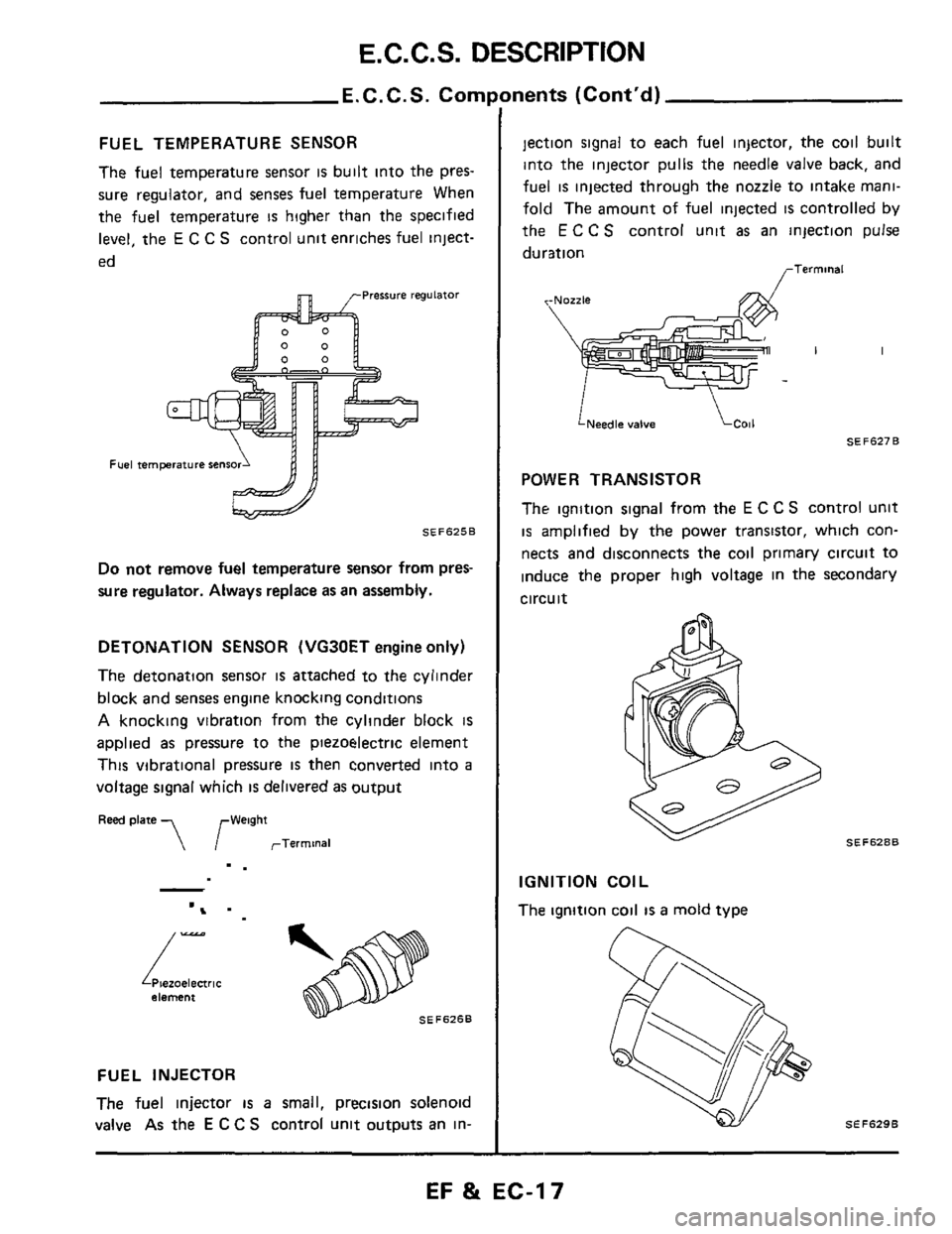
E. C. C. S. DESCRIPTION
E.C.C.S. Corn
FUEL TEMPERATURE SENSOR
The fuel temperature sensor is built into the pres-
sure regulator, and senses fuel temperature When
the fuel temperature
IS higher than the specified
level, the
E C C S control unit enriches fuel inject-
ed
Pressure regulator
Fuel temprature $ens
SEF625B
Do not remove fuel temperature sensor from pres-
sure regulator. Always replace as
an assembly.
DETONATION SENSOR (VG30ET engine only)
The detonation sensor
is attached to the cylinder
block and senses engine knocking conditions
A knocking vibration from the cylinder block is
applied as pressure to the piezoelectric element
This vibrational pressure
IS then converted into a
voltage signal which is delivered as output
Reed plate ,, ,-Weight
rTerminal
-.
Piezoelectric element
SEFSZSB
/-
FUEL INJECTOR
The
fuel injector is a small, precision solenoid
valve As the
E C C S control unit outputs an in-
lnents (Cont’d)
jection signal to each fuel injector, the coil built
into the injector pulls the needle valve back, and
fuel
is injected through the nozzle to intake mani-
fold The amount of fuel injected
is controlled by
the
E C C S control unit as an injection pulse
duration
<-Nozzle
LNeedle valve
SEF627B
POWER TRANSISTOR
The ignition signal from the
E C C S control unit
is amplified by the power transistor, which con-
nects and disconnects the coil primary circuit to
induce the proper high voltage in the secondary
circuit
SEFSZBB
IGNITION COIL
The ignition coil
IS a mold type
EF & EC-17
Page 18 of 79
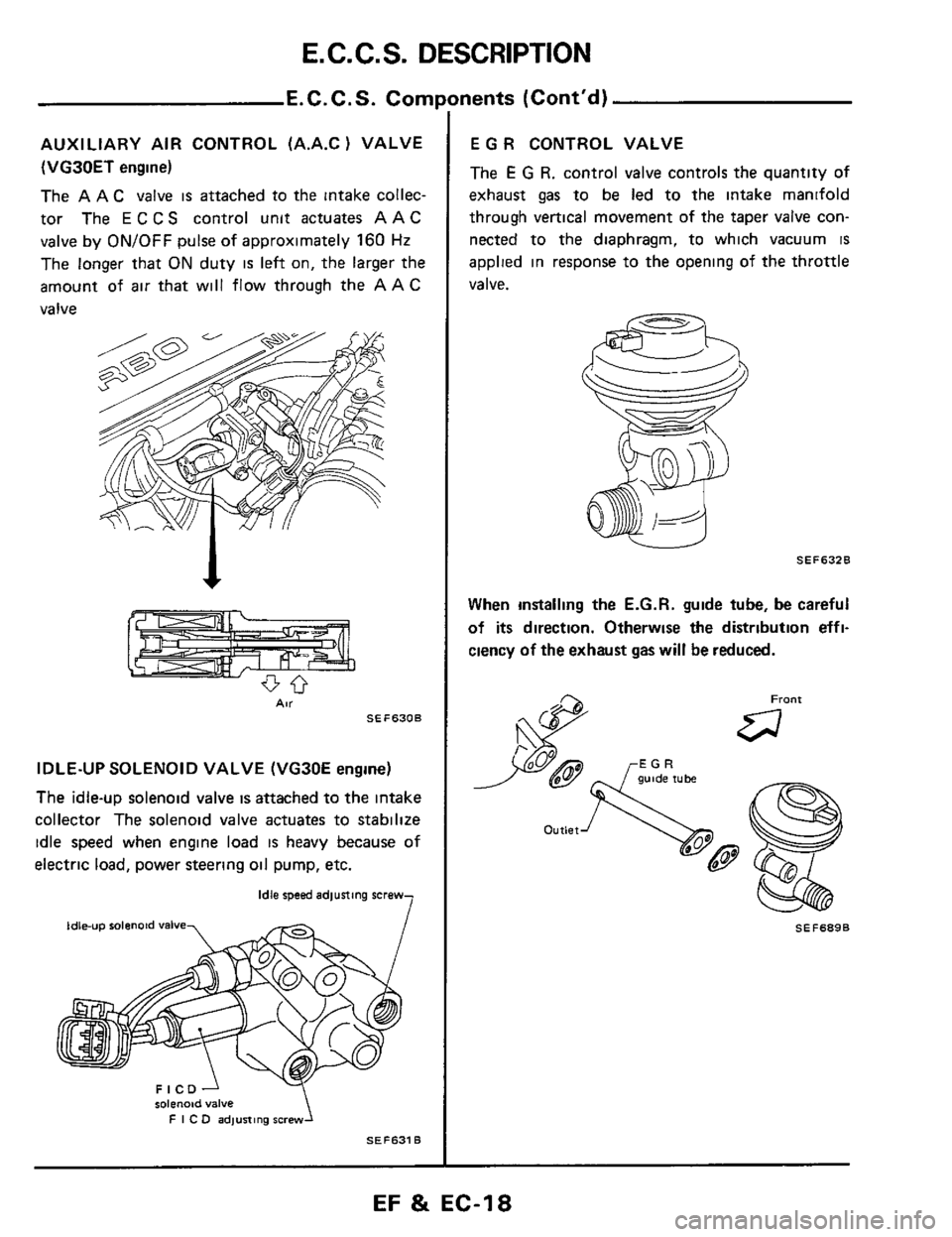
E. C. C. S. DESCRIPTION
E.C.C.S. Corn1
AUXILIARY AIR CONTROL (A.A.C 1 VALVE
(VG30ET
engine)
The
A A C valve is attached to the intake collec-
tor The E C CS control unit actuates AAC
valve by ON/OFF pulse of approximately 160 Hz
The longer that ON duty is left on, the larger the
amount of
air that will flow through the A A C
valve
1
AV SEF630B
IDLE-UP SOLENOID VALVE (VG30E engine)
The idle-up solenoid valve is attached to the intake
collector The solenoid valve actuates to stabilize
idle speed when engine load
is heavy because of
electric load, power steering oil pump, etc.
7
idle speed adiuning screw
ldleup solenoid valve
SEF631 B
FICDJ solenoid valve
F I C D adjusling screw
nents (Cont'd)
E G R CONTROL VALVE
The E G R. control valve controls the quantity of
exhaust
gas to be led to the intake manifold
through vertical movement of the taper valve con-
nected to the diaphragm, to which vacuum
IS
applied in response to the opening of the throttle
valve.
SEF632B
When installing the E.G.R. guide tube, be careful
of its direction. Otherwise the distribution effi-
ciency of the exhaust gas will be reduced.
SEF689B
EF 8i EC-18
Page 19 of 79

E. C. C. S. DESCRIPTION
E.C.C.S. Components (Cont’d)
E.G.R. CONTROL SOLENOID VALVE
E G R control solenoid valve cuts intake manifold
vacuum signal for
E G.R control The solenoid
valve actuates in response to the ON/OFF signal
from
the E C.C S control unit. When the solenoid
is off, vacuum signal from intake manifold is fed
into the
E G R control valve As the control
unit outputs an ON signal, the coil pulls the
plunger downward, and cuts the vacuum signal
9 Atmosphere
ToEGR control valve
From intake
SEF6336 0 manifold
FUEL PUMP
The fuel pump, which is located in the fuel tank, IS
a wet type pump where the vane rollers are directly
coupled to
a motor which is filled with fuel
1 Outlet A
AIR REGULATOR
Air regulator gives an air by-pass when the engine is
cold for the purpose of a fast idle during warm-up
SE F635 B
A bimetal, heater and rotary shutter are built into
the air regulator When the bimetal temperature
IS
low,
the air by-pass port is open As the engine
starts and electric current flows through a heater,
the bimetal begins to rotate the shutter
to close off
the by-pass port The air passage remalns closed
until the engine
is stopped and the bimetal tem-
perature drops
SEF636B
EF & EC-19
Page 24 of 79
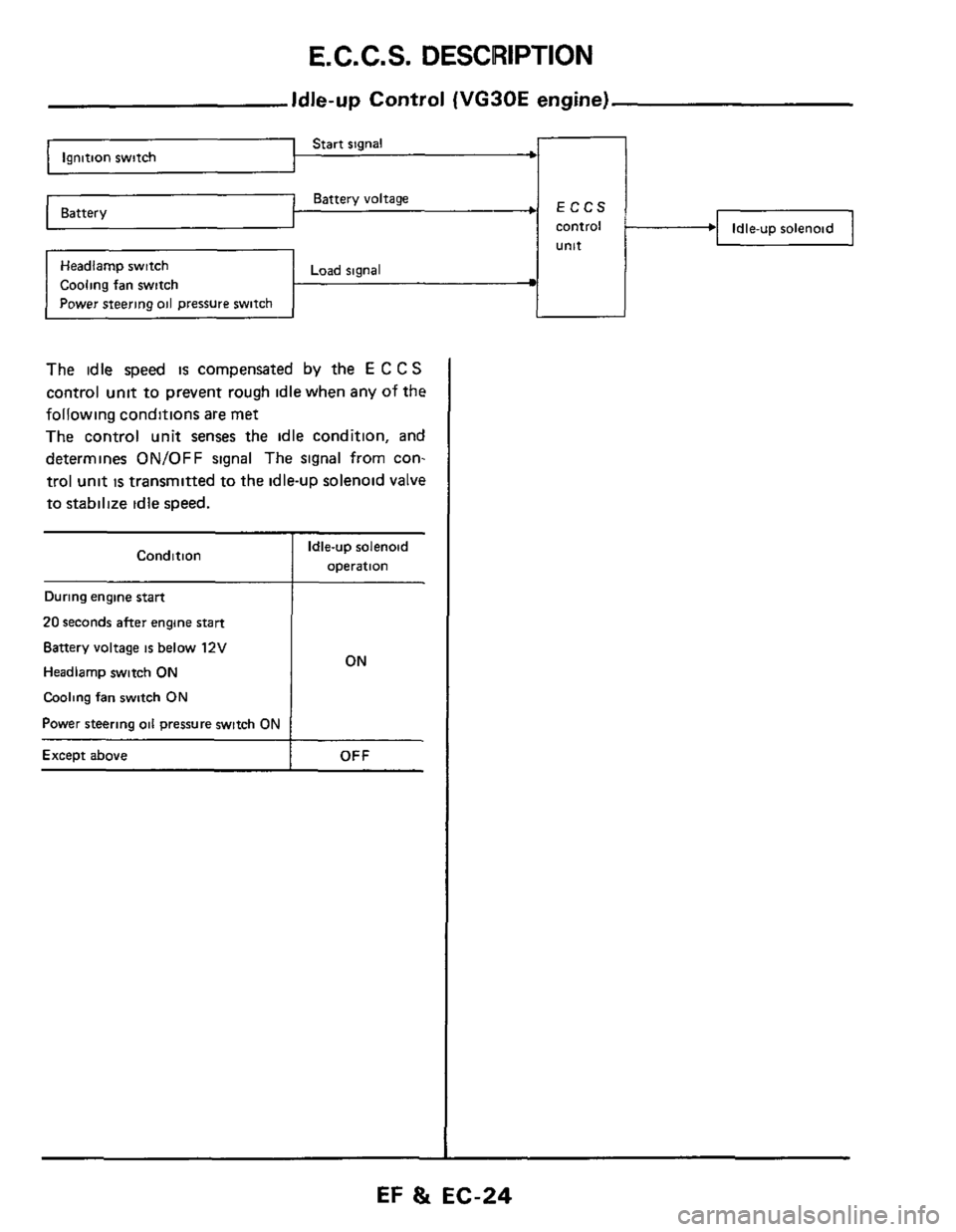
E.C.C.S. DESCRIPTION
Battery voltage Battery
~-
Headlarnp switch Load signal
Cooling fan switch
Power steering oil pressure switch
Idle-up Control (VG30E engine)
Start signal Ignition switch
ECCS
control
unit
The idle speed is compensated by the E C C S
control unit to prevent rough idle when any of the
following conditions
are met
The control unit senses the idle condition, and
determines
ON/OFF signal The signal from con-
trol unit
is transmitted to the idle-uD solenoid valve
to stabilize idle speed.
Condition
During engine start
20 seconds after engine start
Battery voltage is below 12V
Headlarnp switch ON
Cooling fan switch ON
Power steering oil pressure switch ON
Except above
Idle-up solenoid
operation
ON
OFF
EF 8t EC-24
Page 35 of 79
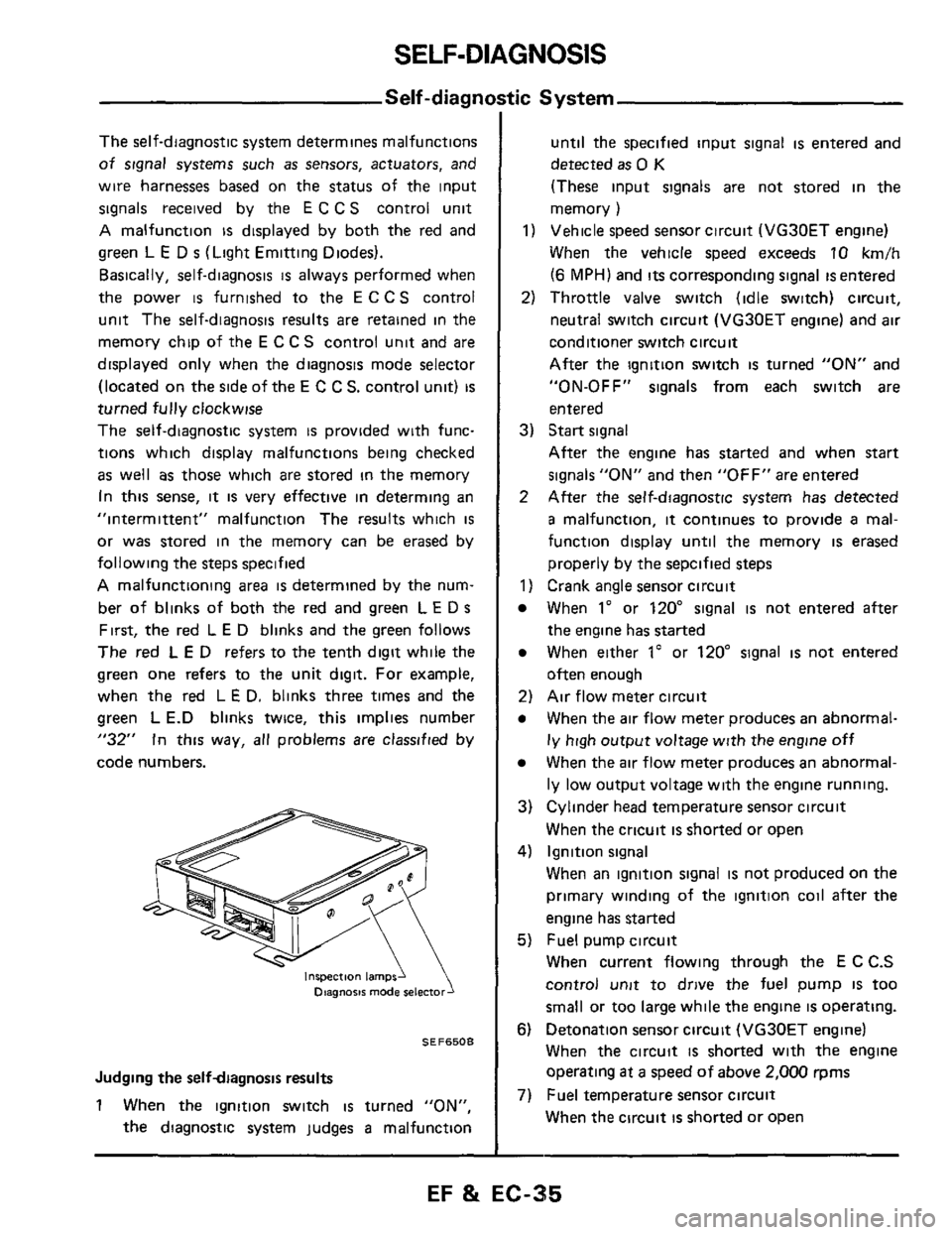
SELF-DIAGNOSIS
Self-diagni
The self-diagnostic system determines malfunctions
of signal systems such as sensors, actuators, and
wire harnesses based on the status of the input
signals received by the
E C C S control unit
A malfunction is displayed by both the red and
green
L E D s (Light Emitting Diodes).
Basically, self-diagnosis
is always performed when
the power
is furnished to the E C C S control
unit The self-diagnosis results
are retained in the
memory chip of the
E C C S control unit and are
displayed only when the diagnosis mode selector
(located on
the side of the E C C S. control unit) is
turned fully clockwise
The self-diagnostic system
is provided with func-
tions which display malfunctions being checked
as well as those which are stored in the memory
In
this sense, it is very effective in determing an
"intermittent" malfunction The results which
is
or was stored in the memory can be erased by
following the steps specified
A malfunctioning area is determined by the num-
ber of blinks of both the
red and green L E D s
First, the red L E D blinks and the green follows
The red L E D refers to the tenth digit while the
green
one refers to the unit digit. For example,
when the red L
E D. blinks three times and the
green
L E.D blinks twice, this implies number
"32" In this way, all problems are classified by
code numbers.
inspection lamps1 Diagnosis mode
SEF6508
Judging the selfdiagnosis results
1 When the ignition switch is turned "ON",
the diagnostic system judges
a malfunction
tic System
until the specified input signal is entered and
detected
as 0 K
(These input signals are not stored in the
memory
)
1) Vehicle speed sensor circuit (VG30ET engine)
When the vehicle speed exceeds
10 km/h
(6 MPH) and its corresponding signal is entered
2) Throttle valve switch (idle switch) circuit,
neutral switch circuit (VG30ET engine) and
air
conditioner switch circuit
After the ignition switch
is turned "ON" and
"ON-OFF"
signals from each switch are
entered
3) Start signal
After the engine has started and when start
signals "ON" and then "OFF" are entered
2 After the self-diagnostic system has detected
a malfunction, it continues to provide a mal-
function display until the memory
is erased
properly by the sepcified steps
1) Crank angle sensor circuit
When 1" or 120" signal is not entered after
the engine has started
When either 1" or 120" signal is not entered
often enough
2) Air flow meter circuit
When the air flow meter produces an abnormal-
ly high output voltage with the engine off
When the air flow meter produces an abnormal-
ly low output voltage with the engine running.
3) Cylinder head temperature sensor circuit
When the cricuit
is shorted or open
4) Ignition signal
When an ignition signal
is not produced on the
primary winding of the ignition coil after
the
engine has started
5) Fuel pump circuit
When current flowing through the E
C C.S
control
unit to drive the fuel pump IS too
small or too large while the engine
is operating.
6) Detonation sensor circuit (VG30ET engine)
When the circuit
is shorted with the engine
operating
at a speed of above 2,000 rpms
When the circuit is shorted or open
7) Fuel temperature sensor circuit
EF & EC-35
Page 67 of 79

TURBOCHARGER
Worn journal or bearing
Inspection (Cont’d)
Replace turbocharger assembly
I Condition 3 Excessively high oil consumption or exhaust shows pale blue smoke I
Probable cause Corrective action
Oil leak at the connection of lubricating oil passage Correct the connection
1. Inspect turbine and compressor wheel as
follows
Visually check for cracks, clogging, deformity
or other damage
Revolve wheels to make sure that they turn
freely without any abnormal noise or friction
Measure play in axial direction
Play (axial direction):
0.013.0.091 mm (0.0005 - 0.0036 in)
SEF726B
2 Check operation of by-pass valve controller
Move by-pass valve to make sure that
it is not
sticking or scratched.
Measure rod end play of the bypass valve con-
troller
Do not apply more than 66.7 kPa (500 mmHg,
19.69 mHg) pressure to controller diaphragm
0.38 mm (0.0150 in)/51.3 - 56.7 kPa
(385 - 425 mmHg, 15.16 - 16.73 inHg)
By-pass valve controller strokelpressure.
,vMercury manometer
,-By-parr valve controller
SEC7278
Always replace the turbocharger as an assembly if
faultv
EF & EC-67
Page 68 of 79
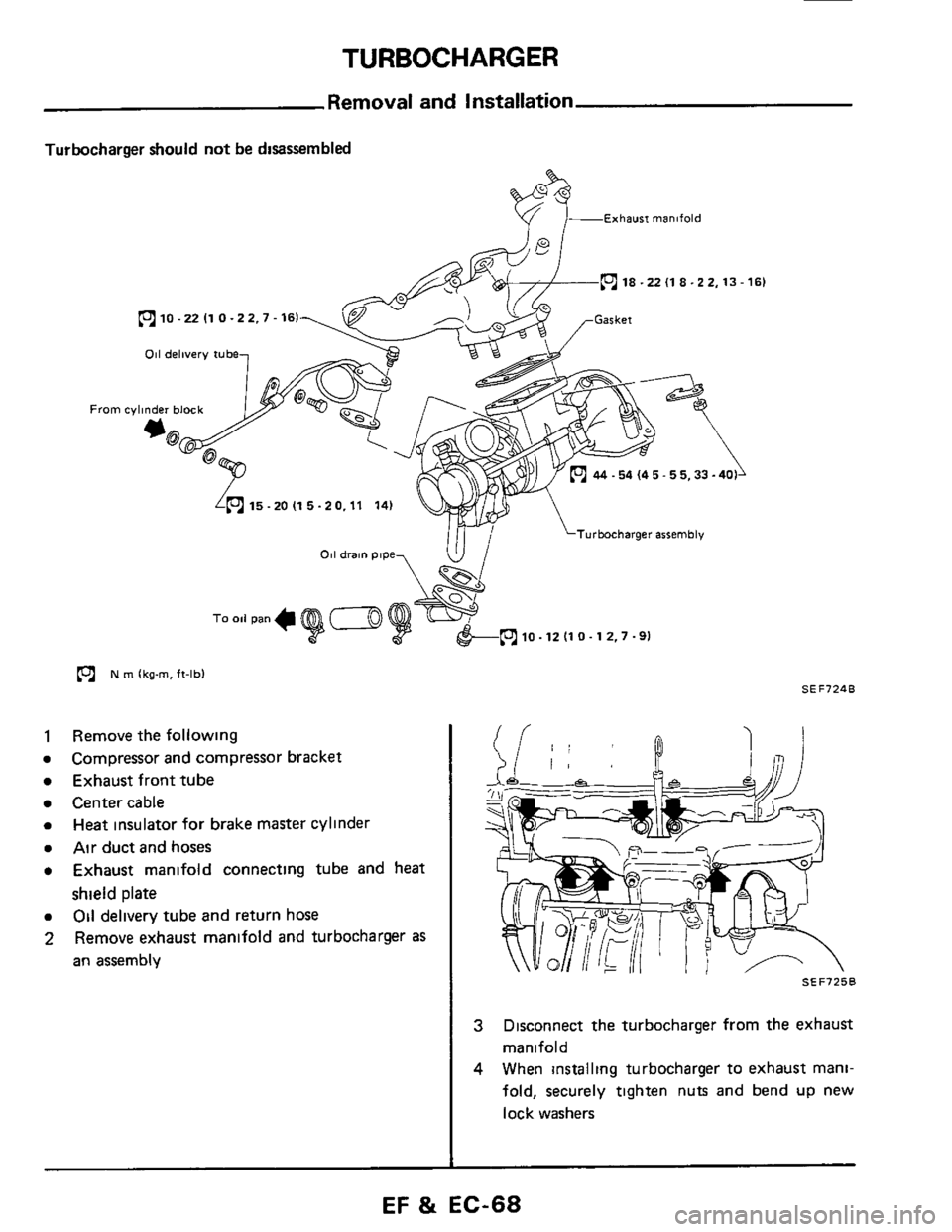
TURBOCHARGER
Removal and Installation
Turbocharger should not be disassembled
&- Exhaw manifold
(c1 18 -22 (1 8-22.13-161
10 -22 I1 0 -22.7.161
011 delivery tube
From cylinder block
*@
15-2OI15-20.11 14)
Turbocharger assembly
p? N m lkg-m. ft-lbl SEF724B
Remove the following
Compressor and compressor bracket
Exhaust front tube
Center cable
Heat insulator for brake master cylini
Air duct and hoses
Exhaust manifold connecting tube and heat
shield plate
Oil delivery tube and return hose
Remove exhaust manlfold and turbocharger
as
an assembly
SEF725B
3
4
Disconnect the turbocharger from the exhaust
manifold
When installing turbocharger
to exhaust mani-
fold, securely tighten nuts and bend
up new
lock washers
EF 8i EC-68
Page 75 of 79

EXHAUST EMISSION CONTROL SYSTEM
-Intake Manifold Vacuum Control-
The vacuum control valve is provided to reduce the
engine lubricating oil consumption when the intake
manifold vacuum increases to
a very high level
during deceleration
The vacuum control valve senses
the manifold
vacuum.
As the manifold vacuum increases beyond
the specified valve, the valve opens and
air IS
sucked into the intake manifold
,-intake collecior
\'I
vacuum COntiOl vaivel
A A C valve or de-up rolenoid valve housing
SEC303A
- Catalytic Converter
The exhaust gas contains unburned, harmful gases
While the mixture ratio
is maintained to the
stoichiometric point by the mixture ratio feedback
system, the three-way catalytic converter activates
to oxidize and reduce harmful
gases (HC, CO and
NO.<) into harmless gases (CO,, H, 0 and N2 1 In
this way, the catalytic converter cleans the exhaust
gas and emits CO,, H,O and N, into the at-
mosphere
E ( C S Control unit? yThree-way catalytic Converter
'h
Exhsurt gar renror,
Hydrocarbon Carbon monoxide nltrogen oxide
Carbon dioxide gar. nitrogen gas, water
SEC304A
EF & EC-75